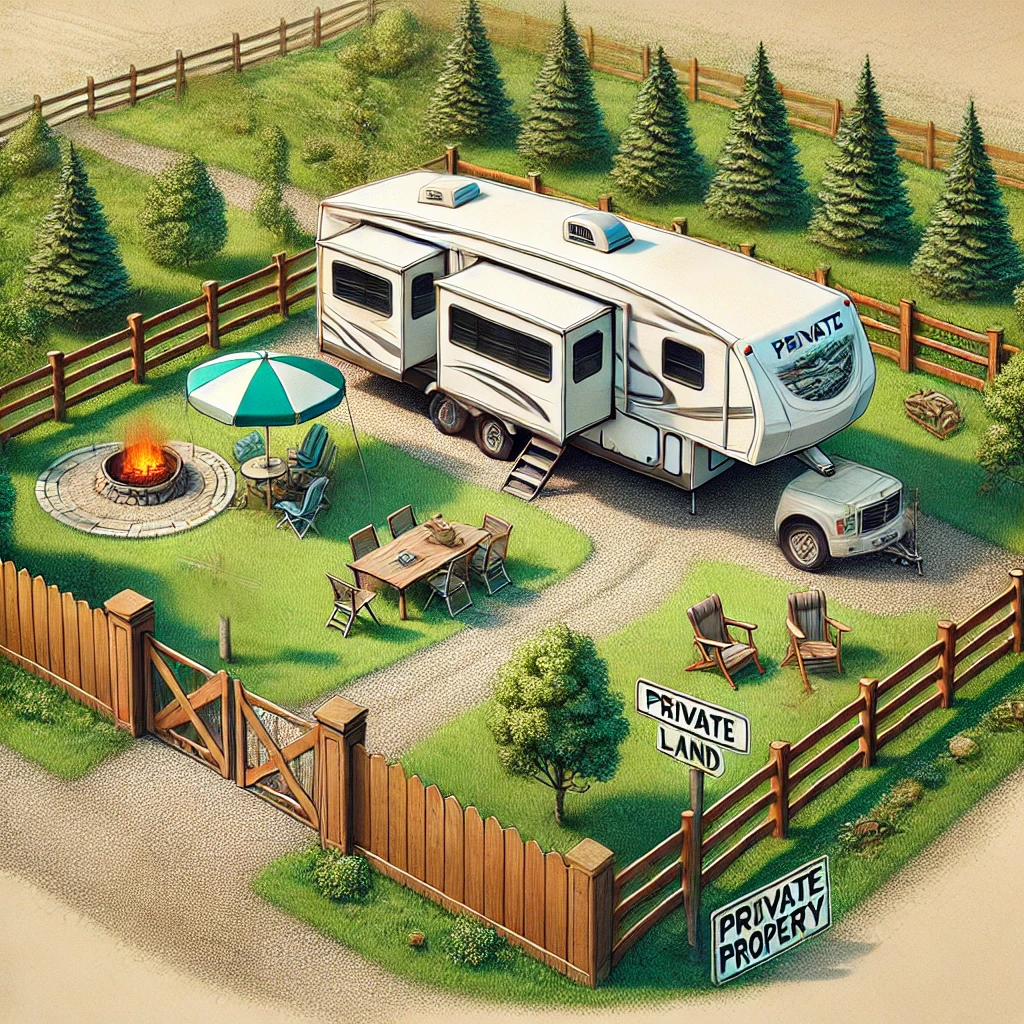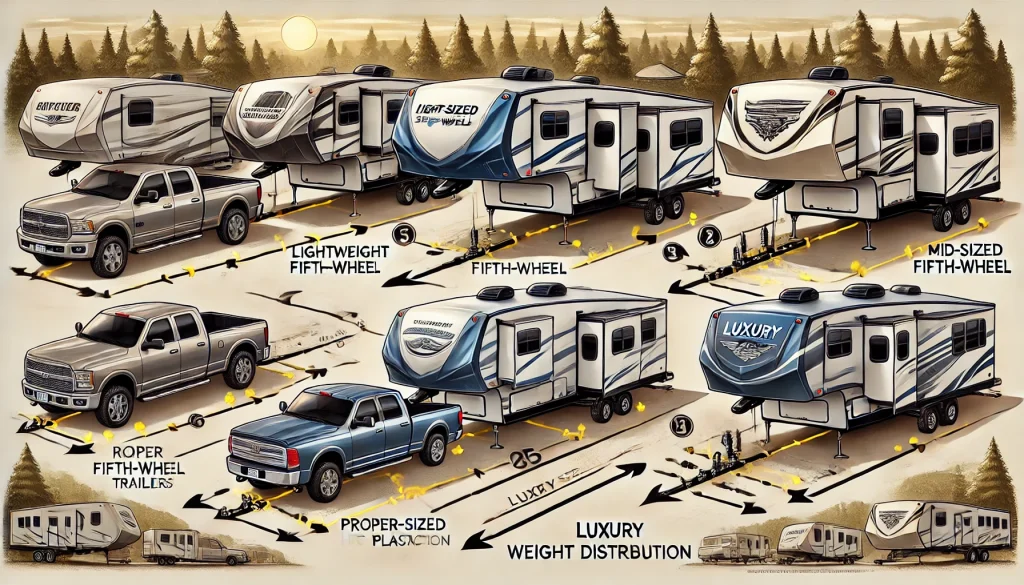Fifth-wheel camper trailers are an excellent choice for comfortable and spacious camping. But deciding where to set up your fifth wheel is just as important as choosing the right one. Let’s explore the best places to park your fifth-wheel camper trailer for a memorable experience.
Best Locations for Setting Up a Fifth Wheel Camper Trailer
Choosing the right location for your fifth-wheel camper trailer depends on your needs and preferences. Here are the top options:
- Campgrounds and RV Parks
Campgrounds and RV parks are the most popular choices for fifth-wheel campers. They offer amenities like:- Full hookups for electricity, water, and sewage
- Access to Wi-Fi, showers, and laundry facilities
- Designated spots for easy parking
- These locations are perfect if you want convenience and access to nearby attractions.
- State and National Parks
If you love nature and scenic beauty, state and national parks are ideal. Many parks accommodate fifth-wheel trailers, but always check size restrictions before planning your trip.
Benefits include:- Peaceful surroundings
- Opportunities for hiking, fishing, and wildlife viewing
- Affordable camping fees

Can I Set My Fifth Wheel Camper Trailer on Private Land?
Yes, private land is a great option for long-term or secluded camping. Make sure you:
- Get permission from the landowner
- Check zoning regulations in the area
- Have access to utilities if needed
Private land provides privacy and flexibility, making it ideal for off-grid camping enthusiasts.

How to Choose the Perfect Spot for Your Fifth Wheel
To find the perfect spot for your fifth-wheel camper trailer:
- Look for level ground to ensure stability.
- Avoid low-lying areas prone to flooding.
- Consider proximity to essential amenities like restrooms and stores.
- Check the weather conditions and forecast to avoid harsh environments.
Why Positioning Is Important for Your Fifth Wheel Camper Trailer
Proper positioning of your fifth-wheel camper trailer is crucial for safety, comfort, and convenience. It not only enhances your camping experience but also protects your trailer and its components from potential damage. Let’s explore why positioning matters and how it can make your trips more enjoyable.
Safety First: Stability and Leveling
Positioning your fifth-wheel camper trailer correctly ensures stability and minimizes risks. Poor positioning can lead to:
- Trailer movement: Uneven ground can cause your trailer to shift or tip.
- Stress on components: Misaligned positioning puts strain on the tires, axles, and hitch.
By parking on level ground and using leveling blocks, you create a stable foundation that keeps you and your trailer safe.
Comfort and Functionality
A well-positioned fifth-wheel camper trailer enhances comfort and functionality. Proper positioning allows you to:
- Avoid tilting: Ensures doors, appliances, and plumbing work efficiently.
- Maximize space: Utilize your slide-outs and awnings without obstruction.
- Enjoy better views: Park strategically to make the most of your surroundings.
Weather Protection
Positioning also helps protect your fifth wheel from harsh weather conditions. For instance:
- Face the wind: Position the nose of the trailer into strong winds for stability.
- Use shade: Park under trees or use your awning to minimize sun exposure and keep the interior cool.
- Avoid flooding: Park on higher ground to prevent water damage during heavy rain.
Convenience and Accessibility
Correct positioning makes your campsite setup more efficient and enjoyable. Consider the following tips:
- Park near essential amenities, like water and power hookups, for easy access.
- Ensure your fifth wheel is positioned to allow unhindered entry and exit.
- Leave enough space for neighboring campers to maintain privacy.

What Position Should the Fifth Wheel Be In?
The position of your fifth-wheel camper trailer plays a vital role in ensuring safety, comfort, and convenience. Whether you’re setting up at a campsite, parking on private land, or preparing for long-term storage, the right positioning can make all the difference. Let’s dive into the ideal positioning for your fifth wheel.
Level Ground is Essential
Your fifth wheel should always be positioned on level ground. Uneven terrain can lead to:
- Instability: Increased risk of tipping or shifting.
- Appliance malfunction: Many RV systems, such as refrigerators, require a level surface to operate correctly.
- Uneven wear: Tires, suspension, and hitch components can experience unnecessary strain.
Use leveling blocks or stabilizers to ensure your fifth-wheel camper trailer is balanced.
Consider the Direction
The direction your fifth wheel faces is also crucial:
- Face into the wind: Position the nose of the trailer into the wind for added stability during windy conditions.
- Optimize shade and sunlight: Orient your camper to minimize direct sunlight exposure during hot days or maximize it in colder conditions.
- Enjoy the view: Position your fifth wheel to take advantage of scenic views at your campsite.
Proximity to Amenities
When parking in campgrounds or RV parks, choose a position that maximizes convenience:
- Align your trailer near hookups for water, electricity, and sewage.
- Ensure enough clearance for slide-outs and awnings.
- Position the entry door facing the campsite for easy access and setup.
Off-Grid Camping and Long-Term Storage
For off-grid or long-term parking:
- Choose a location on high ground to avoid potential flooding.
- Avoid parking directly under trees to reduce the risk of falling branches.
- Leave sufficient space around your fifth wheel for ventilation and maintenance access.

Steps to Set Up Your Fifth-Wheel Camper Trailer
Setting up your fifth-wheel camper trailer correctly ensures a safe, comfortable, and enjoyable camping experience. Follow these easy steps to get your fifth wheel ready for adventure.
Choose the Right Campsite
- Select a level campsite with enough space for your fifth wheel and its slide-outs.
- Check for proximity to hookups, such as water, electricity, and sewage.
- Avoid parking under trees to prevent debris from falling onto your camper.
Position and Level Your Fifth Wheel
- Back into the site using a spotter for guidance if necessary.
- Use a bubble level to check if the trailer is even.
- Place leveling blocks under the tires to adjust the position if needed.
- Lower the front landing gear to stabilize the trailer before disconnecting it from the truck.
Secure and Stabilize
- Chock the wheels to prevent the fifth wheel from shifting.
- Lower the stabilizer jacks to eliminate movement when walking inside the camper.
Connect Hookups
- Attach the power cord to the campsite’s electrical hookup (usually 30 or 50 amps).
- Connect the water hose to the freshwater supply and ensure the pressure regulator is in place.
- Attach the sewer hose to the drain outlet and connect it to the sewage hookup if available.
Extend Slide-Outs and Awnings
- Ensure there’s enough space around the trailer before extending slide-outs.
- Open the slide-outs slowly and check for any obstructions.
- Extend the awning to create a shaded outdoor area for relaxing.
Check Interior Systems
- Turn on the power and test lights, appliances, and HVAC systems.
- Prime the water system by opening faucets and checking for leaks.
- Adjust the thermostat to your preferred temperature.
Set Up Your Campsite
- Arrange outdoor furniture, grills, and other camping gear.
- Secure your belongings to avoid them blowing away in windy conditions.

How to Position Different Classes of Fifth-Wheel Camper Trailers
Fifth-wheel camper trailers come in various classes, each designed to meet specific needs. Proper positioning ensures safety, comfort, and functionality, regardless of the class. Let’s explore how to position different classes of fifth wheels for the best results.
Lightweight
Lightweight fifth wheels are compact and easier to maneuver. Here’s how to position them effectively:
- Choose level ground: Lightweight models are more susceptible to instability on uneven terrain. Use leveling blocks if necessary.
- Face the wind: Position the front of the trailer into the wind to reduce sway during gusty conditions.
- Maximize space: Ensure proper clearance for slide-outs and awnings, especially in tight campsites.
Mid-Size
Mid-size fifth wheels are popular for their balance between comfort and mobility. Consider these tips for positioning:
- Check weight distribution: Ensure the trailer’s weight is evenly distributed on the hitch and axles for stability.
- Orient for views and shade: Position to optimize scenic views and minimize direct sunlight.
- Close to hookups: Align your trailer near water, electric, and sewer connections for easier access.
Luxury
Luxury fifth wheels are larger and heavier, requiring special attention when parking:
- Prioritize stability: Use heavy-duty leveling jacks or stabilizers to support the additional weight.
- Choose a spacious site: Luxury models need more room for slide-outs, so pick a campsite with ample space.
- Consider privacy: Position your fifth wheel to maximize privacy and reduce noise from neighboring campers.
Toy Hauler
Toy hauler fifth wheels are unique because of their garage space for recreational vehicles. Proper positioning involves:
- Account for unloading space: Park in a location with enough room to unload and use your toys, such as ATVs or bikes.
- Ensure a level platform: The garage and living areas must be level to function effectively.
- Secure tie-downs: Check that the tie-downs inside the garage are balanced and secure before parking.
General Tips for All Fifth-Wheel Classes
No matter the class, follow these universal positioning guidelines:
- Avoid low-lying areas: Prevent water pooling during rainstorms.
- Use a spotter: Have someone guide you when backing into tight spaces.
- Check campground restrictions: Ensure the site accommodates the length and weight of your fifth wheel.

Common Mistakes in Positioning a Fifth-Wheel Camper Trailer and How to Solve Them
Positioning your fifth-wheel camper trailer correctly is essential for safety, comfort, and convenience. However, mistakes happen, especially for new owners. Here are the most common positioning mistakes and practical solutions to avoid them.

1. Parking on Uneven Ground
Mistake: Parking on uneven terrain can cause instability, lead to appliances malfunctioning, and create unnecessary stress on the hitch and tires.
Solution:
- Always park on level ground. Use a bubble level to check alignment.
- Carry leveling blocks or ramps to adjust the trailer’s position.
- Stabilize the camper with wheel chocks and stabilizer jacks to prevent shifting.
2. Facing the Wrong Direction
Mistake: Positioning the fifth wheel against strong winds or direct sunlight can lead to discomfort and increased wear.
Solution:
- Face the nose of the trailer into prevailing winds for better stability.
- Use trees, awnings, or sunshades to minimize direct sunlight exposure.
- Orient the trailer to make the most of scenic views without sacrificing functionality.
3. Inadequate Space for Slide-Outs and Awnings
Mistake: Parking too close to obstacles like trees, fences, or other RVs can block slide-outs and awnings from extending fully.
Solution:
- Before parking, measure the clearance needed for your slide-outs and awnings.
- Choose a campsite with enough space to accommodate the full width of your trailer when fully extended.
- Use a spotter to guide you into tight spaces safely.
4. Poor Proximity to Hookups
Mistake: Parking too far from water, electricity, and sewer hookups can make connections difficult and inconvenient.
Solution:
- Align your fifth wheel so the hookups are easily reachable with standard hoses and cables.
- Carry extension cords and extra-long hoses to bridge any gaps.
- Plan your parking spot with hookups in mind to minimize setup effort.
5. Neglecting Drainage Considerations
Mistake: Parking in low-lying areas increases the risk of water pooling around your fifth wheel during heavy rains.
Solution:
- Always choose high ground or sites with good drainage.
- Avoid parking near ditches or depressions that could flood.
- Use leveling blocks to slightly tilt the trailer so water flows away from the entry points.
6. Ignoring Weight Distribution
Mistake: Incorrect positioning of weight can lead to sway, uneven wear on tires, and difficulty in towing.
Solution:
- Ensure the trailer’s weight is balanced between the axles and hitch.
- Avoid overloading one side, especially in trailers with toy hauler garages.
- Use weight distribution systems if necessary to keep the trailer steady during towing.
Final Thoughts on Avoiding Positioning Mistakes
Proper positioning of a fifth-wheel camper trailer requires attention to detail, planning, and the right tools. By addressing these common mistakes—such as uneven parking, incorrect orientation, or poor hookup access—you can enjoy a safer and more comfortable camping experience. Always take your time when setting up your fifth wheel, and don’t hesitate to ask for help if needed.
More related details will be available on Flamingo Motorhomes.

